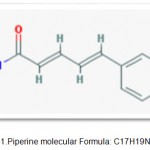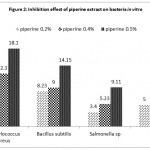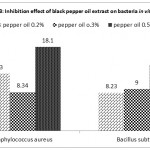How to Cite | Publication History | PlumX Article Matrix
Antibacterial Activity of Piperine and Black Pepper Oil
Nutrition and Food Science, Home Economics Department of Facility, Specific Education, Mansoura University, Egypt.
Corresponding Auther E-mail: dr.daliahikal@gmail.com
DOI : http://dx.doi.org/10.13005/bbra/2697
ABSTRACT: Black pepper (Piper nigrum L.) is known as king of spices and it's sharp taste is due to the presence of piperine which is the main bioactive alkaloid in the fruit. In the present study both of piperine and black pepper oil in different concentrations evaluated for their antimicrobial activity against Staphylococcus aureus (G+ coccoid shaped bacteria), Bacillus subtilis (G+ long spore forming bacteria), Salmonella sp and E.coli (G- short rod bacteria). The inhibition activity was measured by using agar well diffusion method. Piperine and black pepper oil showed antibacterial activity with all tested Gram positive bacteria with zones ranged from 8.23-18.1mm and 3.14-10.43,respectively. The results showed that piperine is an excellent antibacterial agent with all tested bacteria.
KEYWORDS: Antimicrobial; Black Pepper Seeds; Black Pepper Oil and Piperine; Herbs; Spices
Download this article as:| Copy the following to cite this article: Hikal D. M. Antibacterial Activity of Piperine and Black Pepper Oil. Biosci Biotech Res Asia 2018;15(4). |
| Copy the following to cite this URL: Hikal D. M. Antibacterial Activity of Piperine and Black Pepper Oil. Biosci Biotech Res Asia 2018;15(4). Available from: https://www.biotech-asia.org/?p=32494 |
Introduction
Food products should be protected against microorganisms during storage to prevent contamination. Synthetic preservatives have serious health problems with repeated use. So,consumers nowadays concern their efforts to use new natural food additives. Spices and herbs have been used for countries by many cultures enhance the flavor and aroma of foods. In addition, they have used for preserving foods and as natural antimicrobials.11 Pepper is most commonly used in the prescription of ayurvedic and other traditional medicinal systems.6 The oleoresin of black pepper ranged between 10 and 15 percent and it contains volatile oil non volatile oils,resins,fixed oil, colors,sugar etc. The volatile oil lies between between 15 to 35 ml/100g. Pepper ethanol extracts and volatile oils can preserve food from spoilage.12,14 Piperine found naturally in plants belonging to the Piperaceae family,such as Piper nigrum L, commonly known as black pepper . It is the major alkaloid compound accumulate in the skin and seeds of the fruit. It is a solid substance essentially insoluble in water1,7 Figure 1:
 |
Figure 1: Piperine molecular Formula: C17H19NO3.
|
Alkaloids such as piperine have been investigated for their biological and antibacterial activities.9,16 The essential oil of black pepper oil was evaluated for potential inhibition of spoilage moulds in sunflower oil which coated cheeses.17
Materials and Methods
Materials
Plant Material: Black pepper (Piper nigrum L.) seeds were collected from Mansoura markets, Dakahlia, Egypt.
Microbial l Cultures
Four pathogenic bacterial strains were used. These strains were four bacterial strains namely Staphylococcus aureus (G+ coccoid shaped bacteria), Bacillus subtilis (G+ long spore forming bacteria), Salmonella sp and E.coli (G- short rod bacteria).
Methods
Isolation of Piperine from Black Pepper
10 gm black pepper were ground well and extracted with 150 ml 95% ethanol in a soxhelt extractor for 2 hours , the solution is filtered and concentrated in vacuum on a water bath at 60˚c . 10 ml of 10% alcoholic KOH are added to the filtrated residue. The alcoholic solution is left overnight , where upon yellow needles of piperine are deposited,the yield is a bout 0.3 gm.5
Extraction of Oil
The seeds were sieved , dried at 120°C for 2hours and then the oil was extracted by mechanical pressing.
Assessment of Antimicrobial Activities
The antibacterial activity of both piperine and pepper oil was evaluated by using agar well diffusion method. Bacterial cultures are mixed in nutrient agar medium and poured in petriplates. Wells of 5mm size were made with sterile borer into agar plates containing the bacterial inoculum. 2mg of crude piperine was completely dissolved in 2ml of Di Methyl Sulfoxide(DMSO). Antibacterial activity was measured by adding 0.05 ml from both of piperine and pepper oil described by13 with different concentrations as 0.2 ,0.3 and 0.5% into the wells and left them for one hour to allow diffusion, then incubated at appropriate temperature and period of time. At the end of incubation period, the inhibition zones of microbial growth were measured and recorded.2
Results and Discussion
The effect of piperine and black pepper oil as antibacterial agents were listed in the Tables (1 and 2) and Figures (2 and 3). It could be noticed that antibacterial activity of piperine and black pepper oil increase as the concentrations increases. It is supporting the view of.3,4 On the other hand, the maximum zones of inhibition were recorded with both of piperine and black pepper oil at the concentration of 0.5% against all Gram positive bacteria (Staphylococcus aureus and Bacillus subtilis) with zones of 18,1,14,15;10.43 and 8.34mm, respectively. Black pepper oil with all concentrations gave no zones of inhibition against all the Gram negative species and that was inagreement with10 who confirmed that spices like turmeric and ginger extracts have potent antibacterial activity against Gram positive more than Gram negative bacteria through individually and by mixtures. The variation in the inhibition among the Gram positive and Gram negative bacteria is due to the cell wall and cell membrane compositions.15 The sensitivity of E.Coli in compare other Gram negative bacteria to piperine when it used with lowest concentrations resulting from the highly permeable membrane. On the other hand, piperine alteration in the permeability of the cell wall which contain high level of lipid material.8
Table 1: Inhibition effect of black pepper oil extract on bacteria in vitro.
| Concentrations | Procaryotic cells | |||
| G+ | G- | |||
| Staphylococcus aureus | Bacillus subtilis | Salmonella sp | E.coli | |
| 0.2% | 8.34 | 8.23 | 3.4 | 5.0 |
| 0.4% | 12.3 | 9.0 | 5.23 | 6.42 |
| 0.5% | 18.1 | 14.15 | 9.11 | 8.4 |
Values expressed the diameter of inhibition zone in Cm.
G+:Gram positive cells.
G-: Gram negative cells.
Table 2: Inhibition effect of piperine extract on bacteria in vitro.
| Concentrations | Procaryotic cells | |||
| G+ | G- | |||
| Staphylococcus aureus | Bacillus subtilis | Salmonella sp | E.coli | |
| 0.2% | 3.14 | 5.42 | – | – |
| 0.4% | 5.22 | 6.13 | – | – |
| 0.5% | 10.43 | 8.34 | – | – |
Values expressed the diameter of inhibition zone in Cm.
Data given are mean of triplicates.
G+:Gram positive cells.
G-: Gram negative cells.
 |
Figure 2: Inhibition effect of piperine extract on bacteria in vitro.
|
 |
Figure 3: Inhibition effect of black pepper oil extract on bacteria in vitro.
|
Conclusions
Piperine and black pepper oil have potent activity as antibacterial agents especially piperine with both Gram positive and Negative bacteria strains.
Acknowledgements
I owe my loving thanks to my parents, sisters, my husband and my daughter.
References
- Badmaev V.,Majeed M and Norkus E. P. piperine an alkaloid derived from black pepper increases serum of beta – carotene during 14 days of oral beta – carotene supplementation. Nutr. 1999;19:381-388.
- Bagamboula C. F., Uyttendaele M and Debevere J. Antimicrobial effect of spices and herbs on shigeila sonnei and shigeilla flexneri. J. Food. 2003;66(4):668-673.
- Banso A and Adeyemo S. O. Evaluation of antibacterial properties of tannins isolated from Dichrostachys cinerea. J. Biotechnol. 2007;6(15):1785-1787.
- Bobbarala V. P., Katikala P. K., Naidu K. C and Penumajji S. Antifungal activity of selected plant extracts against phytopathogenic fungi Aspergillus niger F2723. Indian. J. Science ans Technol. 2009;2(4):87-90.
- Dawidar A. M.,Abdel-Mogib M.,Metwally M. A and Ayyad H. N. Chemistry of natural products 1st edn. Mansoura Univ. Bublisher. 1998;278-279.
- Emad M and Abdalla W. E. Black pepper fruit (pipper nigrum ) as antibacterial agent:A mini-review.Journal of Bacteriology and Mycology. 2018;6(2):141-145.
- Kumoro A. C., Singh H. y and Hasan M. Solubility of Piperine in Supercritical and Near Critical Carbon Dioxide. Chinese Journal of Chemistry and Engineering. 2009;17(6):1014–1020.
- Obafemi C. A., Sulaimon T. A., Aki D. A and Olugbade T. A. Antimicrobial activity of extracts and agermacranolide. type of sesquiterpene lactone from Tithonia diversifolia leaf extract. Afr. J. 2006;12:1254-1258 .
- Pan Y., Zhu Z., Huang Z., Wang H., Liang Y., Wang K., Lei Q and Liang M. Characterisation and free radical scavenging activities of novel red pigment from Osmanthus fragrans’ seeds. Food Chem. 2009;112:909–913. doi: 10.1016/j.foodchem. 2008.06.077.
- Paul M., Basu S. K and Paul S. Antibacterial activities of ginger(Zingiber officinale Rosc.) and turmeric (Curcumma domestica Loir).Ind.J.Bot.Res. 2006;2(2):103-110.
- Priya N. C and Kumari P. S. Identification of classes of compounds and destimation of flavonoid and phenol from seeds of pipper longum and pepper nigrum. International Journal of Pharma and Bio Science. 2016;7(1):593-601.
- Reineccius G. Source Book of Flavors,2 nd edn.,CBS Publishers Distributors,New Delhi,India. 1997;288-289:315-320.
- Sharma S., Singh A and Baral M. P. Antimicrobial Activities of Essential oils of some common spices.Nepal Journal of Science and Technology. 2002;4:95-100.
- Shingate P. N., Dongre P. P and Kannur D. M. new method development for extraction and isolation of piperine from black pepper.International Journal of Pharmaceutical Sciences and Research. 2013;4(8):3165-3170.
- Rani S. K. S and Udaysree N. S. Antimicrobial activity of black pepper (pipper nigrum ). Global Journal of Pharmacology. 2013;7(1):87-90.
- Sonam C., Sharma K and Uleria S. G. Antimicrobial Activity of some essential oils-present status and future perspectives. Medicines. 2017;4:58.
- Wendroff W. L and Wee C. Effect of smoke and spice oils on growth of molds on oil-coated cheeses.J.of Food Protection. 1997;60(2):153-156.

This work is licensed under a Creative Commons Attribution 4.0 International License.






